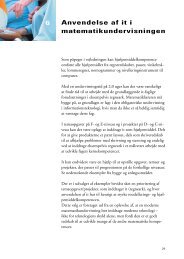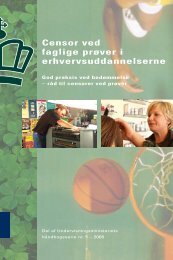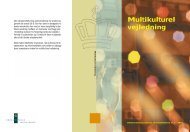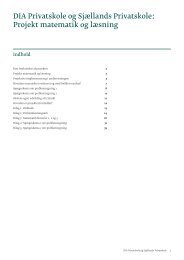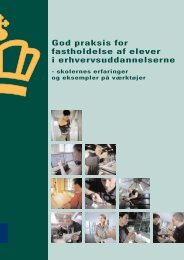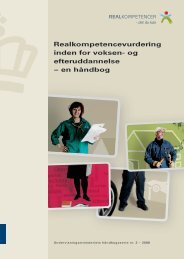The Danish - Undervisningsministeriet
The Danish - Undervisningsministeriet
The Danish - Undervisningsministeriet
Create successful ePaper yourself
Turn your PDF publications into a flip-book with our unique Google optimized e-Paper software.
Introduction to the <strong>Danish</strong> VET system<br />
A definition:<br />
<strong>The</strong> terms VET, initial VET (IVET), and continuing<br />
VET (CVET) are often used in different ways in different<br />
EU Member States. In this publication, the term VET<br />
is used about the system and the programmes providing<br />
recognised vocational qualifications for practice within<br />
a certain trade or profession. <strong>The</strong> VET system includes<br />
four types of programmes: agricultural, commercial, social<br />
and health care and technical programmes. <strong>The</strong> system is<br />
part of the <strong>Danish</strong> youth education system, and as such,<br />
is primarily targeted at young people (16+). However, the<br />
average age of trainees in VET is 22, and the VET system<br />
also offers a wide range of possibilities for adults (25+).<br />
Furthermore, the trend is towards an integration of IVET<br />
and CVET in one system in order to make the provision<br />
of VET transparent, flexible and attractive.<br />
Facts and figures about VET in Denmark<br />
Approximately one third of a youth cohort enrols in a<br />
VET programme after basic schooling (2007). <strong>The</strong>re is a<br />
decrease in the number of young people who enter a VET<br />
programme as the trend is currently for young people to<br />
opt for the more academically-oriented upper secondary<br />
education programmes. <strong>The</strong> most popular programmes<br />
are the commercial, building and construction,<br />
technology and communication, and the social and health<br />
care programmes.<br />
<strong>The</strong> drop-out rate is high. Only around 70% complete<br />
the basic course and 80% complete the main course.<br />
Many of the trainees who drop out continue in other<br />
VET programmes or in the general upper secondary<br />
education programmes. Nonetheless, 40% of all dropouts<br />
are estimated not to continue any education or<br />
training programme within the next ten years. <strong>The</strong> drop-<br />
12





